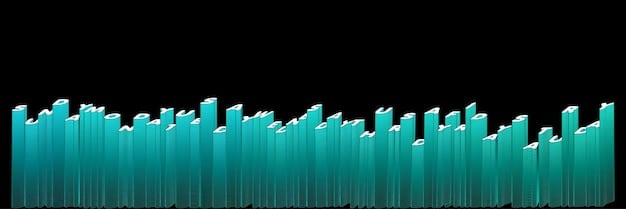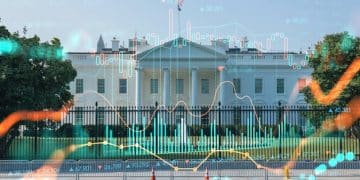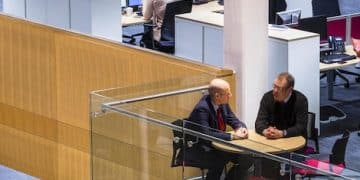Breaking: Fed Raises Rates 0.25% – Impact on US Consumers in 2025

In a move to combat persistent inflation, the Federal Reserve announced a 0.25% interest rate hike; this article explores the potential consequences for consumers in the United States throughout 2025, covering mortgages, savings, and the overall economy.
The Federal Reserve has just announced a 0.25% interest rate hike, sending ripples through the financial world. But what does this really mean for you, the average consumer, in 2025? Let’s delve into the likely effects on your wallet, your savings, and the broader US economy.
Federal Reserve Announces Rate Hike: A Closer Look
The decision by the Federal Reserve to raise interest rates by 0.25% is a direct response to inflationary pressures that continue to affect the US economy. This increase, while seemingly small, has the potential to influence various aspects of consumer finance. Understanding the underlying reasons for this decision is crucial in predicting its impact. The Fed’s dual mandate includes maintaining price stability and maximizing employment; raising interest rates is a tool used to cool down an overheating economy and curb inflation.
Why Now? Understanding the Fed’s Decision
The Federal Reserve closely monitors economic indicators such as the Consumer Price Index (CPI) and the unemployment rate to make informed decisions about monetary policy. Persistently high inflation, coupled with a strong labor market, often prompts the Fed to take action. By increasing borrowing costs, the Fed aims to reduce consumer spending and investment, which in turn can help to bring inflation under control.
The Mechanics: How Rate Hikes Work
When the Federal Reserve raises the federal funds rate, it influences the interest rates that banks charge each other for overnight lending. This, in turn, affects the prime rate, which is the benchmark rate that banks use to set interest rates for many consumer and business loans. As the prime rate increases, borrowing becomes more expensive, potentially leading to reduced spending and investment.

Here are some key factors that play a role in this process:
- Inflation Targets: The Fed typically aims for an inflation rate of around 2%. When inflation exceeds this target, the Fed may raise interest rates to bring it back down.
- Economic Growth: The Fed also considers the overall health of the economy. Raising interest rates too aggressively can slow down economic growth and potentially lead to a recession.
- Global Factors: International economic conditions and geopolitical events can also influence the Fed’s decisions.
In conclusion, the Federal Reserve’s decision to raise interest rates is a complex one, driven by a variety of economic factors. By understanding the underlying reasons for this decision, consumers can better anticipate its potential impact on their finances.
Impact on Mortgages and Home Buying
One of the most significant ways the Fed’s rate hike will affect consumers is through mortgages. As interest rates rise, so do mortgage rates, making it more expensive to buy a home. This can have a cooling effect on the housing market, potentially leading to lower home prices and reduced sales volume. For those with existing adjustable-rate mortgages (ARMs), monthly payments are likely to increase as the benchmark rate adjusts.
New Homebuyers: Affordability Challenges
The increase in mortgage rates presents a significant challenge for new homebuyers. Even a small increase in the interest rate can translate to thousands of dollars in additional costs over the life of a mortgage. This can make it more difficult for people to qualify for a mortgage and may force some to delay their home buying plans.
Existing Homeowners: Refinancing Considerations
For homeowners who are considering refinancing their mortgages, the rate hike may make it less attractive to do so. If current mortgage rates are higher than their existing rate, refinancing may not result in significant savings. However, it’s still important to compare rates from different lenders to see if any opportunities exist.
Here are some factors for homeowners and potential homebuyers to consider:
- Shop Around: Compare mortgage rates from multiple lenders to find the best deal.
- Consider a Fixed-Rate Mortgage: A fixed-rate mortgage provides stability, as the interest rate remains the same for the life of the loan.
- Factor in Closing Costs: Remember to account for closing costs, which can add thousands of dollars to the total cost of buying or refinancing a home.

In summary, the Fed’s rate hike is likely to have a significant impact on the housing market, making it more expensive to buy a home and potentially reducing the number of people who can afford to do so. Both new homebuyers and existing homeowners should carefully consider their options and shop around for the best deals.
Effects on Savings Accounts and Investments
While higher interest rates can be challenging for borrowers, they can be beneficial for savers. Banks and credit unions may increase the interest rates they offer on savings accounts, certificates of deposit (CDs), and other savings products. This can help consumers earn more on their savings, especially in high-yield accounts. However, the impact on investments can be more complex, with potential fluctuations in the stock market and bond yields.
Savings Accounts: A Silver Lining?
One positive aspect of the rate hike is the potential for higher interest rates on savings accounts. As banks compete for deposits, they may offer more attractive interest rates to attract customers. This can help consumers earn more on their savings and better keep pace with inflation.
Investment Strategies: Navigating Volatility
The impact of the rate hike on investments can be more nuanced. Rising interest rates can put downward pressure on stock prices, as higher borrowing costs can reduce corporate profits. Bond yields may also increase, leading to lower bond prices. However, these changes can also create opportunities for savvy investors to buy low and potentially profit from future gains.
Some investment strategies to consider during a rate hike include:
- Diversify Your Portfolio: Spreading your investments across different asset classes can help to reduce risk.
- Consider Value Stocks: Value stocks, which are often undervalued by the market, may be more resilient during periods of rising interest rates.
- Rebalance Your Portfolio: Regularly rebalancing your portfolio can help to ensure that it remains aligned with your investment goals and risk tolerance.
In conclusion, the Fed’s rate hike can have both positive and negative effects on savings and investments. While savers may benefit from higher interest rates on savings accounts, investors should be prepared for potential volatility in the stock market and bond yields. Diversifying your portfolio and seeking professional advice can help you navigate these challenges.
Impact on Credit Cards and Loans
The Federal Reserve’s rate hike directly influences interest rates on credit cards and other variable-rate loans. Credit card interest rates, which are typically variable, will likely increase, making it more expensive to carry a balance. Consumers with existing credit card debt may see their monthly payments rise. Similarly, interest rates on personal loans, auto loans, and other variable-rate loans are also likely to increase.
Credit Card Debt: Paying It Down
With credit card interest rates on the rise, it’s more important than ever to pay down high-interest debt. Consider strategies such as balance transfers, debt consolidation loans, or simply making extra payments to reduce your outstanding balance. The sooner you pay off your debt, the less you will pay in interest charges.
Auto Loans and Personal Loans: Evaluating Options
If you’re planning to take out an auto loan or personal loan, shop around for the best interest rates and terms. Consider whether a fixed-rate loan or variable-rate loan is the best option for your situation. A fixed-rate loan provides stability, while a variable-rate loan may offer a lower initial interest rate but could increase over time.
Here are some tips for managing credit card debt and loans:
- Create a Budget: A budget can help you track your income and expenses and identify areas where you can cut back.
- Prioritize Debt Repayment: Focus on paying off high-interest debt first, such as credit card balances.
- Negotiate Lower Rates: Contact your credit card company or lender to see if they will lower your interest rate.
In summary, the Fed’s rate hike is likely to increase interest rates on credit cards and other loans, making it more expensive to borrow money. Consumers should take steps to manage their debt and shop around for the best interest rates and terms.
The Broader Economic Impact
Beyond the direct effects on consumers’ wallets, the Federal Reserve’s rate hike can have a broader impact on the US economy. Higher interest rates can slow down economic growth, reduce inflation, and affect the labor market. These effects can ripple through various sectors of the economy, influencing business investment, consumer spending, and overall economic activity. The ultimate goal is to achieve a sustainable level of economic growth without excessive inflation.
Slowing Down Economic Growth
One of the intended effects of the rate hike is to slow down economic growth. By making borrowing more expensive, the Fed aims to reduce consumer spending and business investment. This can help to prevent the economy from overheating and reduce inflationary pressures. However, it also carries the risk of slowing down growth too much and potentially triggering a recession.
Controlling Inflation
The primary goal of the rate hike is to control inflation. High inflation can erode purchasing power and make it more difficult for consumers to afford essential goods and services. By reducing consumer spending and business investment, the Fed hopes to bring inflation back down to its target level of around 2%.
Here are some potential broader impacts on the economy:
- Business Investment: Higher borrowing costs can discourage businesses from investing in new equipment, technology, and expansion projects.
- Consumer Spending: Reduced consumer spending can lead to lower sales and revenues for businesses, potentially leading to layoffs.
- Labor Market: A slowdown in economic growth can lead to job losses and higher unemployment rates.
In conclusion, the Federal Reserve’s rate hike can have a significant impact on the broader economy, influencing economic growth, inflation, and the labor market. While the goal is to achieve a sustainable level of economic growth without excessive inflation, there are risks involved in slowing down the economy too much.
Strategies for Consumers to Adapt
Given the potential impact of the Federal Reserve’s rate hike on consumers, it’s important to develop strategies to adapt and protect your financial well-being. This includes reviewing your budget, managing debt, and making informed financial decisions. By taking proactive steps, you can minimize the negative effects of the rate hike and position yourself for financial success.
Reviewing Your Budget
One of the first steps you should take is to review your budget and identify areas where you can cut back on spending. This can help you free up more money to pay down debt or save for the future. Consider reducing discretionary spending, such as dining out, entertainment, and travel.
Managing Debt
With interest rates on the rise, it’s more important than ever to manage your debt effectively. Focus on paying down high-interest debt, such as credit card balances, and avoid taking on new debt if possible. Consider strategies such as balance transfers, debt consolidation loans, or simply making extra payments to reduce your outstanding balance.
Some adaptive behaviours to adopt:
- Build an Emergency Fund: An emergency fund can help you cover unexpected expenses without having to rely on credit cards or loans.
- Shop Around for Insurance: Compare insurance rates from different providers to ensure that you’re getting the best deal.
- Seek Professional Advice: Consider consulting with a financial advisor to get personalized advice on how to manage your finances during a period of rising interest rates.
In summary, adapting to the Federal Reserve’s rate hike requires a proactive approach to managing your finances. By reviewing your budget, managing debt, and making informed financial decisions, you can minimize the negative effects of the rate hike and position yourself for financial success.
| Key Point | Brief Description |
|---|---|
| 🏠 Mortgage Impact | Higher rates mean increased costs for new and existing homeowners. |
| 💰 Savings Boost | Potential for better returns on savings accounts and CDs. |
| 💳 Credit Card Costs | Increased interest rates on credit card balances. |
| 📈 Economic Slowdown | Efforts to curb inflation may lead to slower economic growth. |
Frequently Asked Questions (FAQ)
▼
The Federal Reserve raised interest rates to combat inflation, aiming to slow down economic growth and reduce inflationary pressures. This helps maintain price stability.
▼
New homebuyers will face higher mortgage rates, making it more expensive to buy a home. Those with adjustable-rate mortgages may see increased monthly payments.
▼
Yes, banks may increase interest rates on savings accounts and CDs to attract customers, leading to potentially higher returns on your savings.
▼
Focus on paying down high-interest credit card debt. Consider balance transfers or debt consolidation to lower interest rates and reduce your overall debt burden.
▼
Diversify your investment portfolio across different asset classes and consider consulting with a financial advisor to navigate potential market volatility effectively.
Conclusion
The Federal Reserve’s decision to raise interest rates will have a multifaceted impact on consumers in 2025. From mortgages and savings accounts to credit cards and investments, understanding these effects is crucial for making informed financial decisions and adapting to the changing economic landscape. By taking proactive steps to manage your finances, you can navigate these challenges and secure your financial well-being.





